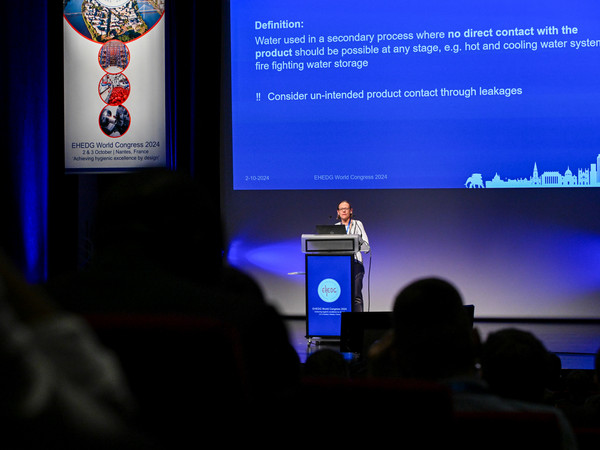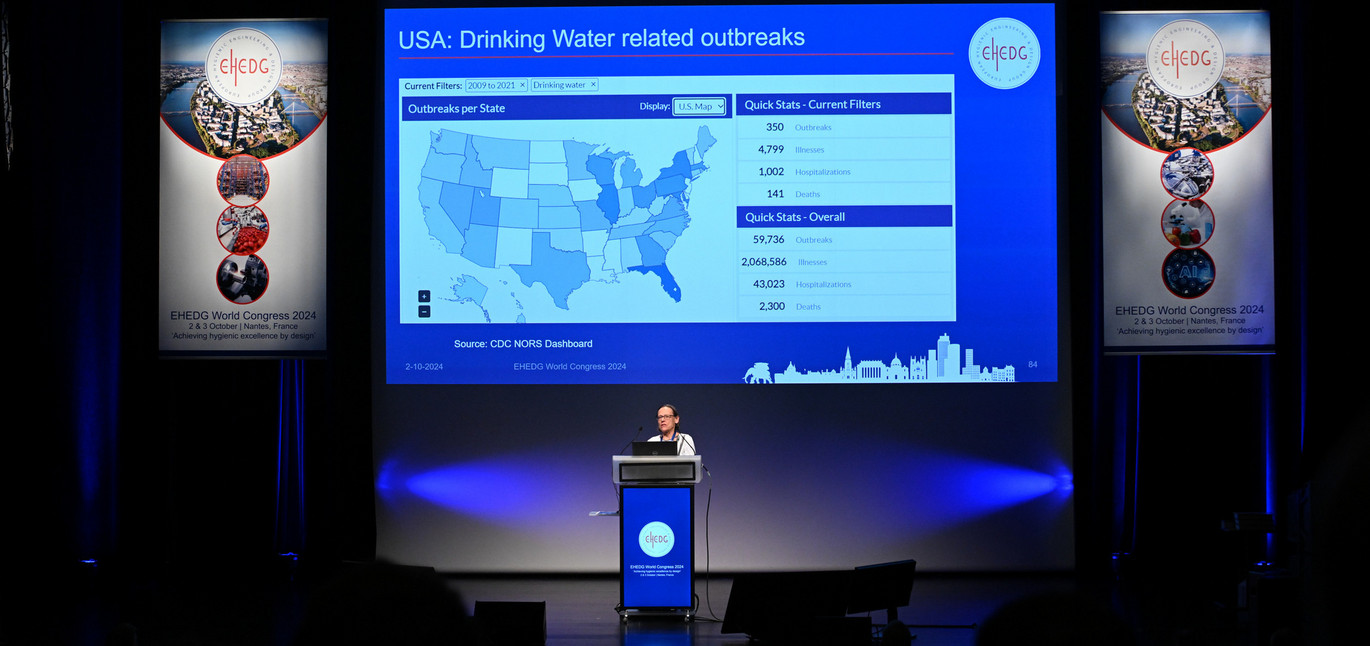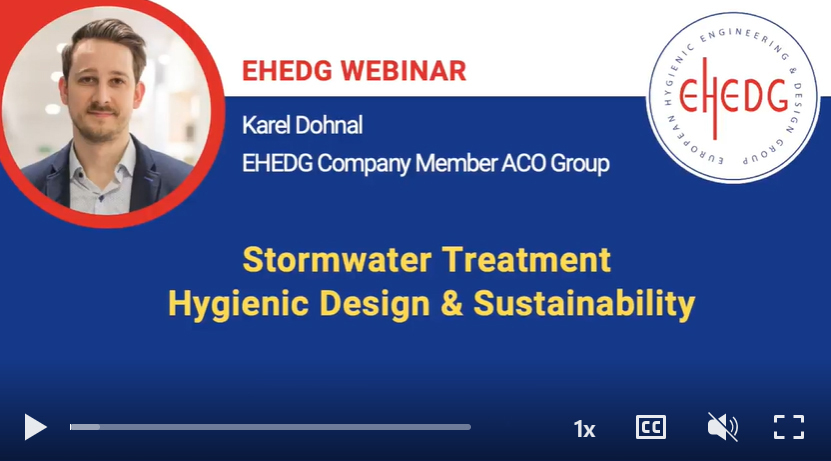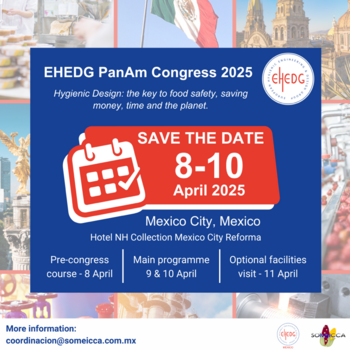Sustainable Use of Stormwater in the F&B Industry: an interview with Anett Winkler
In an exclusive interview with Anett Winkler, Chair of EHEDG WG 28 on Water Management in the Food and Beverage Industry, we learn about key trends and innovations in sustainable Stormwater harvesting. Anett shares her insights from the recent EHEDG Congress and offers insight into future updates to the guidelines regarding alternative water sources.

“Most importantly, a targeted risk assessment is needed to identify the hazards and subsequent risks associated with new water sources.”
What was your impression of the last EHEDG Congress in Nantes? What topics did you think resonated most in the discussions?
It has been a great conference for networking, meeting with old and new colleagues – and discussing actual topics. Certainly everyone could choose among the wealth of topics discussed, however from my perspective sustainability was a big one linking several fields together: hygienic design to facilitate cleaning (and thereby minimizing amount of cleaning chemicals / water), saving energy and towards using alternative sources for water (as being our WG)
One of the big issues at the moment is sustainability. As chair of one of the EHEDG working groups, can you give us an overview of how the working groups are preparing and anticipating the inclusion of alternative water sources in the guideline updates, and what steps are being taken to ensure that these practices are in line with both hygiene standards and sustainability goals?
Sustainability I have been mentioned above, and specifically in the guideline we are working on we, as a group, have considered and added additional water sources as well as added a chapter on new developments, which could support minimization of chemical usage in water treatments. The added water sources have been discussed in the group and reviewed to capture their major advantages and also necessary precautions / treatments to ensure the water originating from those sources will be fit-for-purpose. The most important point to consider is the performance of a targeted risk assessment to determine the hazards and then risks related to those new water sources. Based on the outcome of that risk assessment respective treatments for the intended uses should be determined.
With reference to your presentation, could you elaborate on when it is appropriate to use stormwater within the context of water utilization in F&B industry?
As outlined above, the potential or intended usage will be included in the risk assessment. If adequate treatments are used (and available) storm water could be used for many purposes – if adequately assessed and treated. Often such approaches could be limited by the financial impact of required treatments, but it will depend on the benefits for the user. We need to keep in mind that on our planet all water is re-used at a certain stage in time – even if that time counts in thousands of years. Having treatments in place, like membrane filtration developed in the 1960ies, will help us achieving the water quality needed for the intended purposes, and even expanding the potential for new intended uses.
Could you describe scenarios in the F&B industry where using stormwater for non-potable purposes offers clear advantages over other water sources, and what benefits it brings to such processes? Additionally, how can safety and efficiency be ensured in these systems while addressing the necessary hygienic precautions?
That links back to what has been said several times before: following a risk assessment potential use can be manyfold – and usage of storm water for different applications will depend on the treatment requirements to determine how to achieve the fit-for-purpose water quality needed for the intended use. That will also depend on the regulatory framework in place and the cost-benefit analyses for any required treatment to get there. Using storm water could also help companies to minimize the discharge of their water and instead of paying for discharge treat and use the water for their purposes.
As the demand for sustainable water practices for non-potable uses grows, what design innovations do you foresee that could enhance the safe reuse of stormwater for this kind of activities in F&B industry? Are there particular technologies or methods you believe have strong potential?
I am not sure that I`ll be the right person to ask that question, since as a microbiologist my focus is different form engineering and their developments. However, by leading this group I could see and hear about several technologies. At this moment membrane filtration technologies in particular – and I would also include here electrodialysis reversal (EDR), as well as plasma-activated water show potentials for future development. This is having in mind minimization of chemical usage.
Can you reveal the biggest discoveries we can expect in the next update of document 28?
I am not sure I would use the word “discoveries” here but would rather refer to a much-needed update due to the developments on sustainability and requirements to safe water in operations. That goes hand in hand with innovations in technologies for water treatments – and more to come - as well as looking at and exploring new water sources, such as storm water. I`d think that in future we may be able to re-use all water – when appropriately risk-assessed and treatment technologies are not only available, but also affordable for the industry to use. In that respect not only the water needs to be risk-assessed, but also the new technologies to ensure their application won`t add any unknown risks to the water.

Anett Winkler began her career at Kraft Jacobs Suchard in December 1998, where she led the research microbiology laboratory in Munich. Anett played a key role in establishing the scientific foundation for microbiological process controls in low moisture foods by conducting validation studies for nut and cocoa processing. She then took on a regional role in Microbiology for the Eastern European, Middle East, and African regions, where she designed global food safety programs, developed training modules on food safety, and supported supplier development. Additionally, Anett served as the global expert for thermal processing at Mondelez International.
In October 2017, Anett transitioned to a new role as the "EMEA Food Safety Advisor" at Cargill. In this position, she provides support to all Cargill businesses in Europe, the Middle East, and Africa on microbiological and food safety issues. Anett is actively involved with EHEDG, where she chairs the Working Group on Water Management, and with ILSI Europe, where she chairs the Microbiology Food Safety Task Force. She is also a member of the ICMSF and co-editor of the Handbook on Food Hygiene in Germany.
Unlock the Secrets to Efficient Stormwater Treatment
Learn today's environmental requirements, standards and innovations in the EU and other countries.
Explore how hygienic design increases the efficiency of stormwater treatment systems, minimizes the risk of disease and waterborne pollutants, and protects consumer health - all while reducing downtime, extending the life of infrastructure, and helping to achieve sustainability goals.

